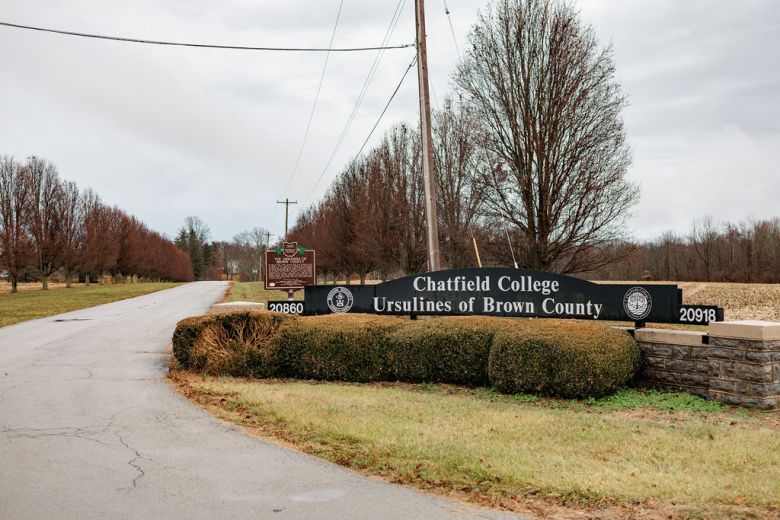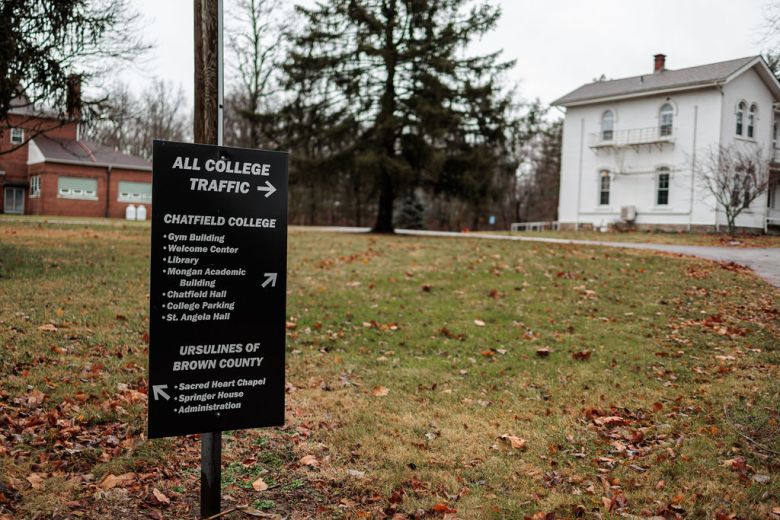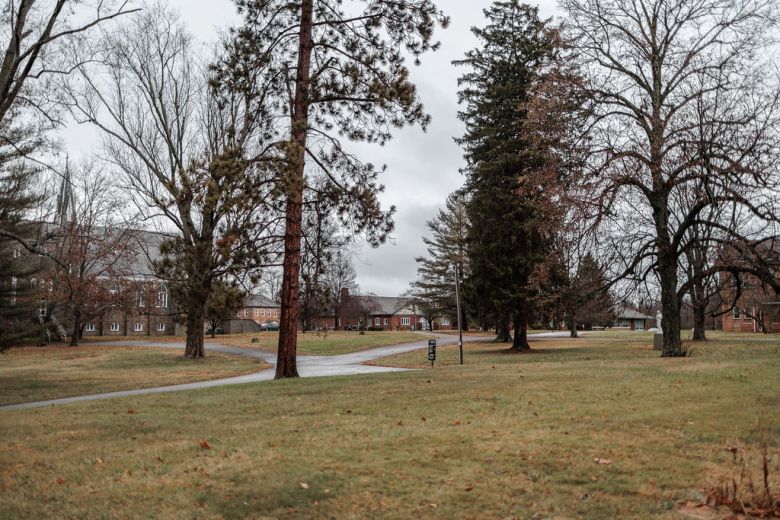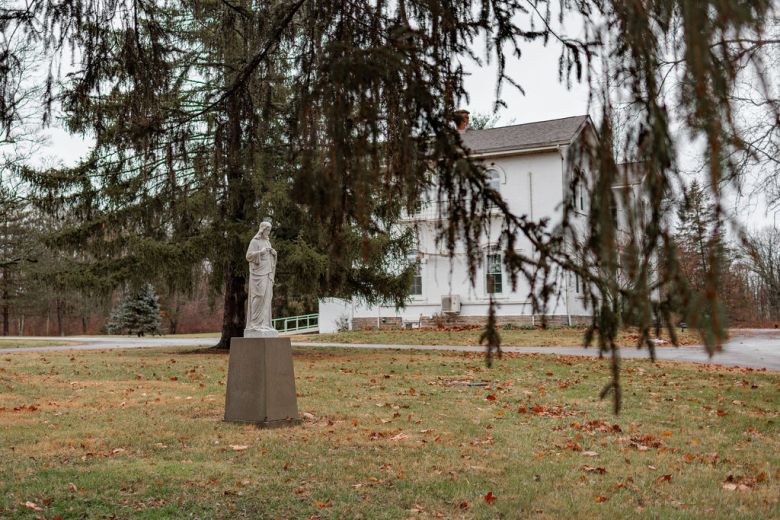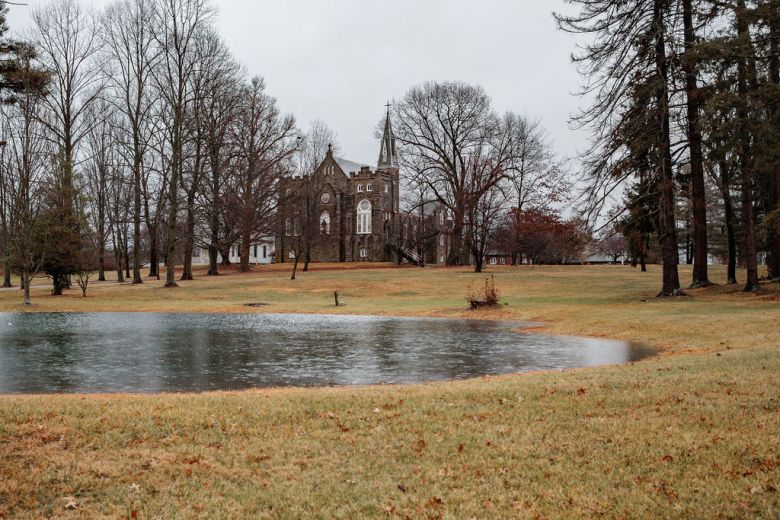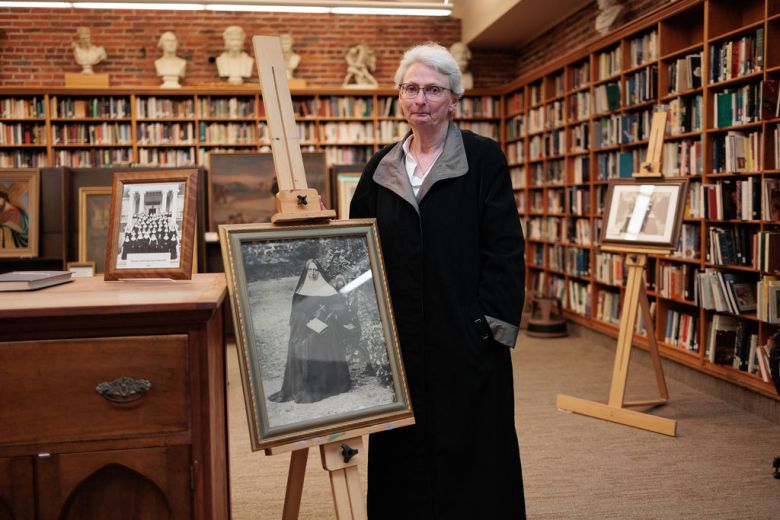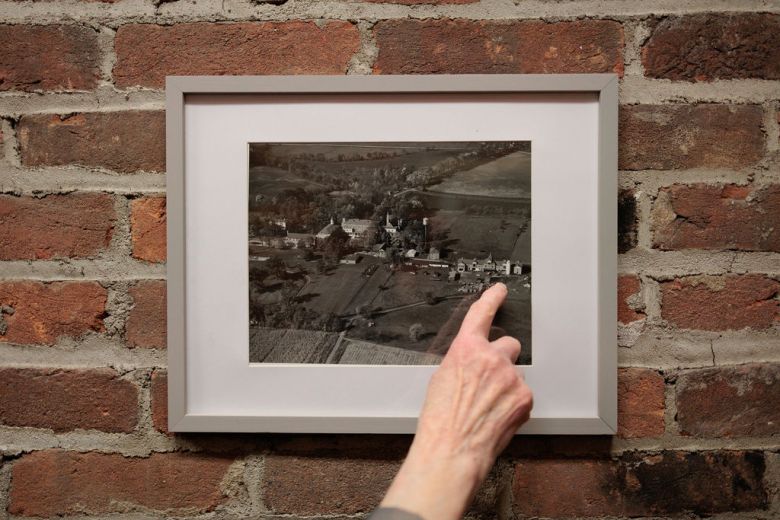FAYETTEVILLE, Ohio — Ghosts populate the campus of Chatfield College.

They’re in the fading photos on the library walls of students who, over 177 years, attended the college and the boarding school from which it sprang, and of the Ursuline nuns who taught them, in their simple tunics and scapulars.
Amid seemingly endless acres of tobacco, soybean and wheat farms in a village in southwest Ohio with a population of 241, the now-closed college sits at the end of a narrow entrance road flanked by Bradford pear trees, colorless and bare in the winter gloom. Just about the only traffic on the way is an occasional stray chicken.
Chatfield has been shut down for a year now, though the buildings and grounds remain so neatly tended that they look as if they’re ready for the students to return. It’s among a fast-growing number of closed colleges in rural America, stripping communities of nearby higher education options to which young people can aspire and eventually go.
SLIDESHOW
In this case, however, something unusual has happened: The assets left by the defunct college are being used to help at least some local students continue their educations past high school.
It’s a story that underscores the role played by colleges and universities in rural America, what’s lost when they close and how advocates are trying to keep the proportion of rural high school graduates who go to college from falling even further than it already has.
“It was a really great starting point for me, and it could have been a starting point for other students,” said Anna Robertson, 23, who attended Chatfield until the end.
Related: Rural universities, already few and far between, are being stripped of majors
Locals once saw greater potential for the college, which was founded in 1845 as a boarding school by an English-born Ursuline nun named Julia Chatfield. In the early 20th century, it benefited from being close to U.S. 50, a heavily trafficked major east-west route. And in 1971, it evolved into Chatfield College, which conferred two-year associate degrees.
“It was the heart of the area,” said Amber Saeidi Asl, who grew up next to the campus. She took courses offered by Chatfield through a dual-enrollment program while she was still in high school, and eventually went there.
Just having a college nearby inspired her to go, she said.
“The people of the area really wanted a college,” Sister Ellen Doyle, president from 1986 to 1997, said in a video history.
“A lot of kids that wouldn’t otherwise go to college felt comfortable coming here,” Mary Jacobs, a Chatfield graduate who later worked as its director of finance, said on the video. “If it hadn’t been for this college, a lot of them wouldn’t have attended college at all.”
But the interstate highway system long ago supplanted U.S. 50. Even the village where the college was located, St. Martin, was dissolved in 2011, when the population had dwindled to 129; the campus was absorbed into Fayetteville.
Like other small, rural, tuition-dependent and religiously affiliated institutions, Chatfield grew even more imperiled as Americans increasingly questioned the cost and value of postsecondary education. There are only about 80 two-year private, nonprofit colleges left, fewer than half as many as just 30 years ago.
It’s also in a part of the country that has been among the most acutely affected by a decline in the number of high school graduates and their interest in going to college. The number of students in Ohio’s public high schools slid by 7 percent from 2012 to 2022, and the percentage of them going directly to college fell to 53 percent by 2020, the most recent year for which the figure is available — nearly 10 percentage points below its peak, and well below the national average of 62 percent.
Related: MIT, Yale and other elite colleges are finally reaching out to rural students
Even though Chatfield accepted everyone who applied, and charged a comparatively low $14,080 in tuition and fees, it was down to 129 students in its last semester, according to federal data. Nearly half took their classes exclusively online.
With an annual budget of around $4.5 million, the college lost $373,520 in 2020 and $850,202 in 2021, tax records show.
“We could see the enrollment trends,” said Robert Elmore, Chatfield’s last president. “We just didn’t see how we could sustain this and continue operating.”
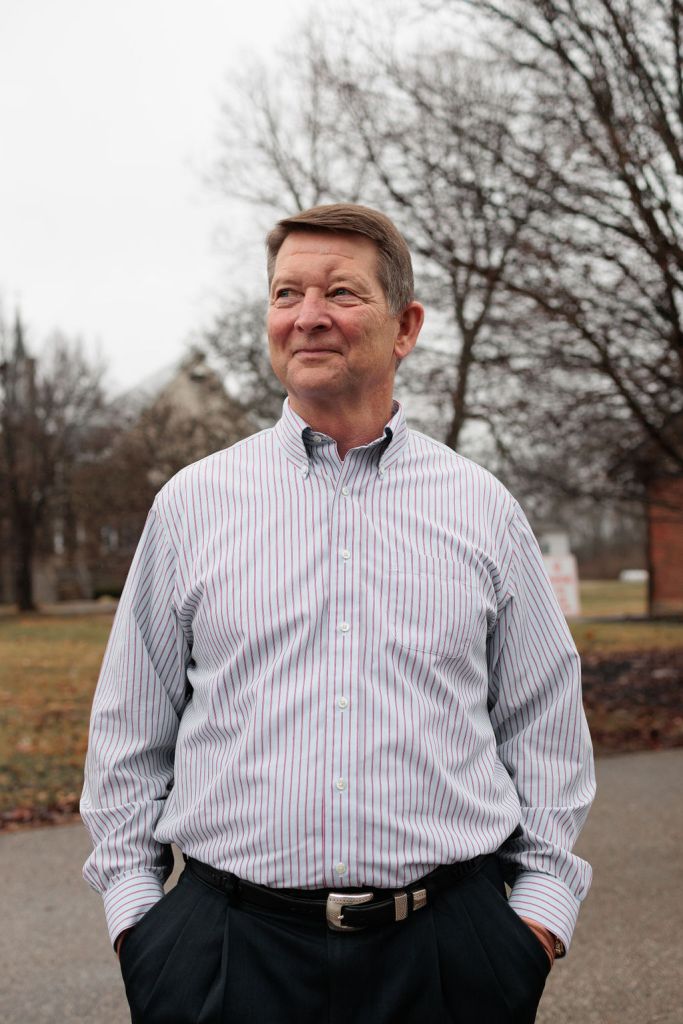
So the school announced in the fall of 2022 that it would shut down at the end of that semester, taking 70 jobs with it. It barely made the headlines. But it had joined more than a dozen other private, nonprofit universities and colleges in rural areas or that serve rural students that have closed or announced their closings just since 2020.
Those include Nebraska Christian College, Marlboro College in Vermont, Holy Family College in Wisconsin, Judson College in Alabama, Ohio Valley and Alderson Broaddus universities in West Virginia, Magdalen College of the Liberal Arts in New Hampshire, Iowa Wesleyan University, Marymount California University, Cazenovia College in New York, Finlandia University in Michigan, Presentation College in South Dakota and Lincoln College, Lincoln Christian University and MacMurray College in Illinois.
Nearly 13 million Americans now live in places, mostly in the Midwest and Great Plains, where the nearest college or university is beyond a reasonable commute away, the American Council on Education reports. The nearest colleges to the Chatfield campus — a community college and a branch of the University of Cincinnati — are about 45 minutes away.
Related: A campaign to prod high school students into college tries a new tack: Making it simple
“For a lot of college students who are living in rural areas, it’s just not feasible to drive to one of the city universities,” said Robertson.
Helping overcome those kinds of obstacles is now the purpose of the nonprofit set up with the remaining Chatfield College endowment, which Elmore put at $4 million; the organization also claims the grounds and buildings as assets, valued along with the endowment at $11 million.
Called the Chatfield Edge, it has provided volunteer mentors, career counseling, assistance with admission and financial aid applications and other help to 21 students, and scholarships of about $1,500 per semester to 19 of them, said David Hesson, director of programs, who was an associate dean at the college.
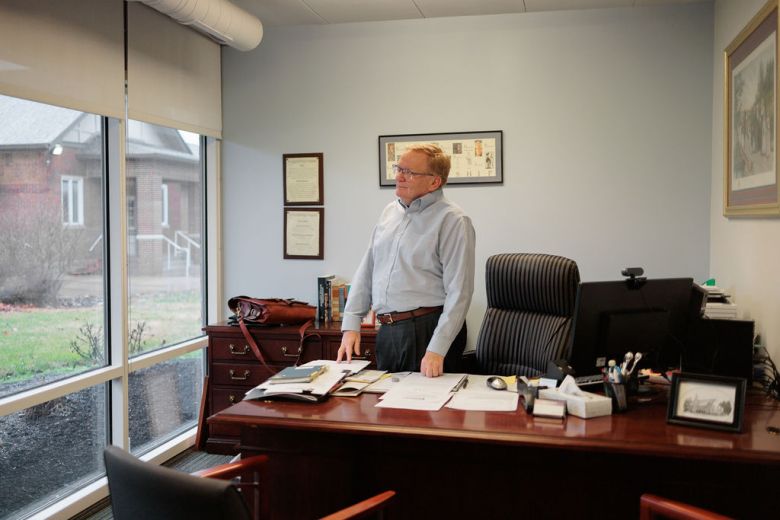
It’s not only about getting students to college; the Chatfield Edge will also help with trade school and certificate programs. The target is low-income high school students who would be the first in their families to go to college and students who are older than the traditional age. Robertson, who now is finishing her bachelor’s degree at Asbury University in Kentucky, is among the beneficiaries.
“We said we don’t have to necessarily provide the education. But we could support them, and we know what that looks like, and we have the scholarship money to cover the gap,” Elmore said.
Other than Hesson and Elmore, the only employees left are a facilities director and the director of development. They work in the onetime student center. “We’re the whole gang,” said Hesson as he held open the door for some rare visitors. An Ursuline sister, Patricia Homan, has an office in a separate, otherwise empty building, and spends time in the library compiling an archive of the college’s history.
The small number of students it has helped so far speaks to the challenges faced by the Chatfield Edge and other organizations promoting access to college and other education after high school for young people growing up in rural places.
“A lot of the kids I knew grew up to do what their parents did,” said Saeidi Asl, who now volunteers as a mentor. “If your parents were farmers, you became a farmer. If your parents were truckers, you became a trucker.”
Related: Often overwhelmed on big campuses, rural college students push for support
That was not the case for Destiny Jones, who also was at Chatfield when it closed. “I didn’t think I was going to do well in the workforce without an education,” Jones said. “I’m a person who needs to be told how to do something.” Plus, “it was going to lead to a higher-paying job.”
Jones, who is 21, was speaking at a daycare center where she works during breaks to help make money for tuition at Mount Saint Joseph University in Cincinnati, which she now attends on her way to getting a degree in art education and becoming a teacher.
Going to Chatfield was much easier. “I didn’t feel like I had to stress about not being able to get there,” she said. Now, at Mount Saint Joseph, “I definitely get pretty homesick, especially in the middle of the semester.” As someone who is close to her family, “I didn’t want to be away.”
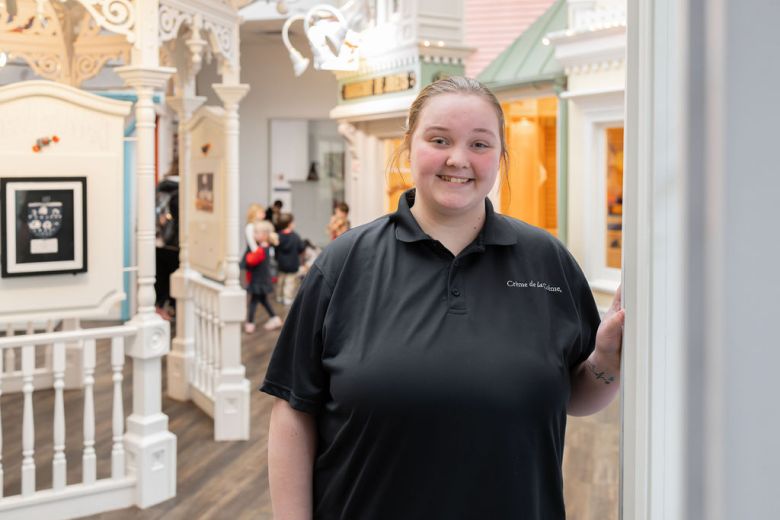
Chatfield’s very existence, Jones said, “made people think about college because it was close by.” Still, many of her high school classmates didn’t go. They took “blue-collar jobs, working in restaurants, doing mechanical work, construction — anything they can get their hands on.”
Rural high school graduates are far less likely to go directly to college than their suburban counterparts, according to the National Student Clearinghouse Research Center — 56 percent, compared to 62 percent, respectively. That’s down substantially in just the last three years.
A big reason for that is a lack of confidence, said Hesson. “They don’t think they can do it. It’s unknown.” And without a college close by, “you lose accessibility.”
Related: Aging states to college graduates: We’ll pay you to stay
Rural students who do go to college generally prefer to stay close to home, research shows.
Robertson, for instance, had never driven on a highway before Chatfield’s closing forced her to transfer to her Kentucky university, nearly two and a half hours away, which has 1,395 undergraduates.
“She said Asbury is such a big college, and I cracked up, because it’s not,” said April Houk, a Fayetteville resident who is Robertson’s volunteer mentor. “She was kind of like a deer in the headlights.” So Houk sent her a bouquet of flowers and some words of encouragement at the beginning of the school year; two weeks later, Robertson had joined some extracurricular clubs, found a friend to study with and was majoring in equine science with plans to become a veterinarian.
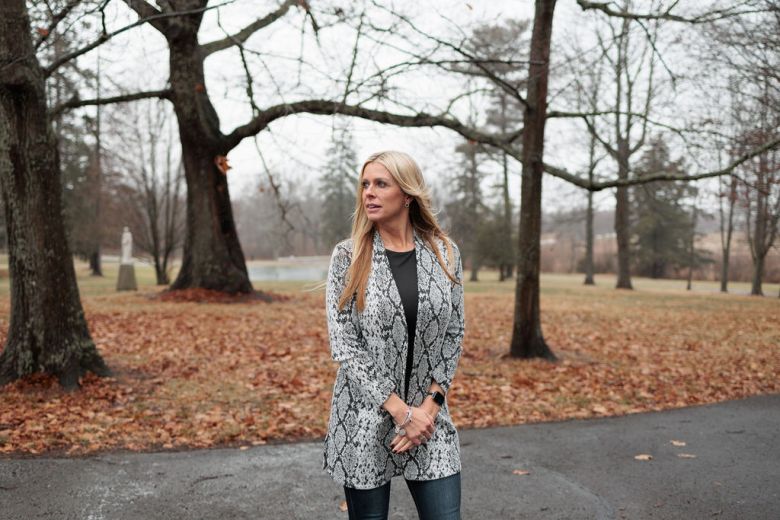
Still, Robertson said, she misses having a college closer to home, which was also cheaper, since she could commute. Her new life “is a pretty different experience,” she said, “because I’m living away from home for the first time. It’s a much bigger campus. There’s more of a sense of anonymity. It can be a little lonely.”
Small rural colleges are more supportive, said Homan, the Ursuline nun and archivist, who also went to Chatfield and later worked there and at a tiny branch campus in Cincinnati that has also closed. “I was the cheerleader,” she said. “I found students if they didn’t show up. If they didn’t have bus fare, we would help them with that.”
Her experience of working in the area “is that the older generation says, ‘I don’t have a college education and I did fine.’ Students aren’t looking for a college education. It is not the aspiration.”
Many, when they’re older, find they do need one, however. That was the case for Jackie Schmidt, who got her associate degree at Chatfield and went on to a successful career as an office manager and accounting manager before helping start a contract manufacturing company. When she was laid off — “I was 54 and had the rug pulled out from under me” — she found “the jobs I thought I was qualified for required a bachelor’s degree.” But “I was intimidated at this age to be going back to school.”
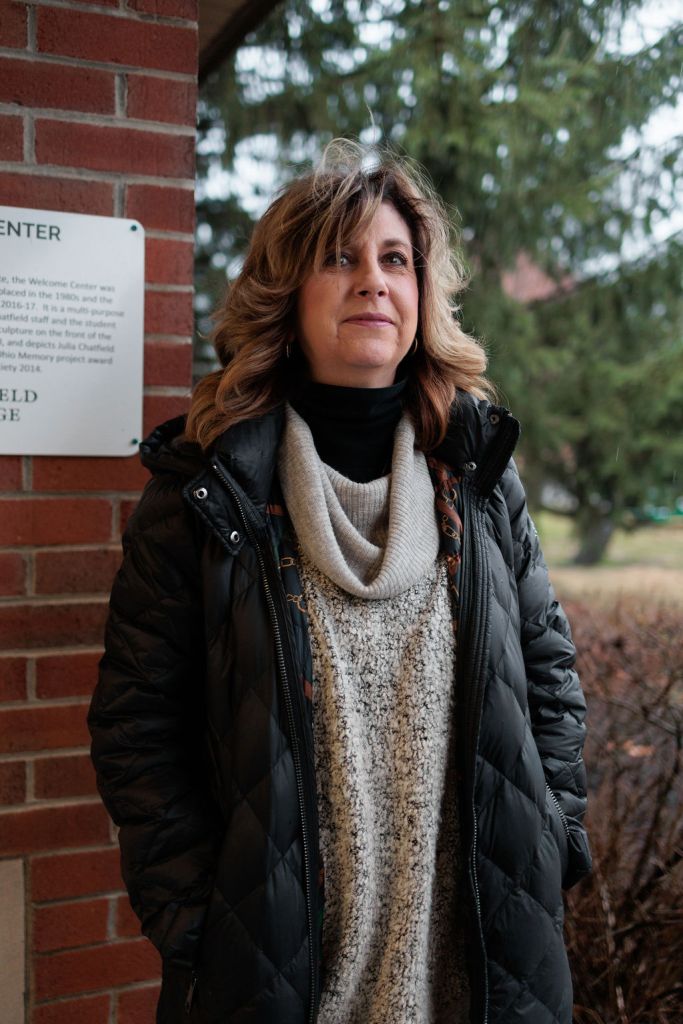
Schmidt, now 56, found her way to the Chatfield Edge and with its help enrolled in an online bachelor’s degree program in business administration.
With rural colleges closing, she said, “I worry because not only for kids just getting out of high school but adults who decide they want to go back to school — what avenues do they have?”
Chatfield College created a sense of community not only for its students, but for the surrounding township, said Houk, who lives a mile from the campus on a 1,300-acre farm. Her husband’s grandmother worked there as a cook, and Houk went to summer camps at Chatfield and was married in the chapel. “We loved this place,” she said. “It really has a lot of history.”
She looked around at the all-but-abandoned campus. “It almost makes you emotional — the integrity it brought to the community.” Even though it’s no longer operating, she said, “I still say, ‘I live one mile from Chatfield College at the stop sign.’ It’s sad to have it gone.”
Without the college, “We lose that educational opportunity and the gifts that these young people have if they were educated,” said Homan, who is now on the board of the Chatfield Edge and Schmidt’s mentor. She, too, looked around the campus. “Oh my gosh, it’s quiet. But it lives on. It does. I know that.”
This story about rural higher education was produced by The Hechinger Report, a nonprofit, independent news organization focused on inequality and innovation in education. Sign up for our higher education newsletter.




